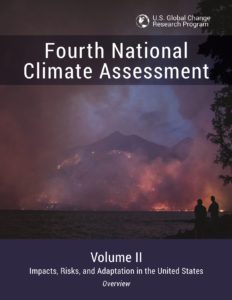Does the New National Climate Assessment Hurt the Trump Administration in Court?
The Report Could Affect a Number of Cases
 The newly released Fourth National Climate Assessment is a bombshell. It catalogues, in excruciating detail, the dire health, economic, and environmental consequences of unchecked climate change on every region of the United States. And although the Trump Administration appears to have tried to minimize the report’s political and public impact by dropping it on Black Friday, the timing of the release is immaterial to whether the report will affect numerous court cases involving climate change. The report lays out in startling detail not only those ways in which the United States will be affected by climate change in future years but also acknowledges effects that are already occurring. Its findings may well undermine the Trump Administration’s attack on regulations that cut greenhouse gas emission and help environmental plaintiffs in other ways. Here are some cases (and doctrines) that could be affected:
The newly released Fourth National Climate Assessment is a bombshell. It catalogues, in excruciating detail, the dire health, economic, and environmental consequences of unchecked climate change on every region of the United States. And although the Trump Administration appears to have tried to minimize the report’s political and public impact by dropping it on Black Friday, the timing of the release is immaterial to whether the report will affect numerous court cases involving climate change. The report lays out in startling detail not only those ways in which the United States will be affected by climate change in future years but also acknowledges effects that are already occurring. Its findings may well undermine the Trump Administration’s attack on regulations that cut greenhouse gas emission and help environmental plaintiffs in other ways. Here are some cases (and doctrines) that could be affected:
The freezing of auto standards at 2020 levels (currently proposed, not yet finalized). The Obama Administration issued standards that gradually increase combined fuel economy and greenhouse gas emissions standards for passenger automobiles and light trucks so that by 2025, fleet averages for cars are supposed to reach around 50 miles per gallon. The Administration is proposing to freeze the standards at 2020 levels based on a series of arguments that have been heavily critiqued on various grounds. But the legal basis for freezing the standards may be especially weak with the issuing of the new report. As I explained in a previous post, in simple terms, freezing the standards at 2020 levels violates the Clean Air Act because greenhouse emissions will increase under the proposal and the increase in emissions will endanger public health and welfare. Massachusetts v. EPA, the landmark Supreme Court case, required the Environmental Protection Agency to determine whether greenhouse gases emitted from vehicles (which the Court held are “pollutants” under the Clean Air Act) endanger public health and welfare. In 2009, EPA made such an endangerment finding based on the overwhelming scientific consensus that emissions of greenhouse gases are warming the atmosphere and creating climate change. Based on this endangerment finding, EPA, in conjunction with the National Highway Transportation and Safety Administration, issued the first set of combined GHG/fuel economy standards — for 2012-2016 – with cooperation from California. EPA and NHTSA then adopted a second set of standards for 2017-2025. Given that EPA has found that greenhouse gases from automobiles endanger public health and welfare, what is the rationale for freezing the standards at 2020 levels, causing an increase of 2.2 billion tons of emissions as a result? The new National Climate Assessment updates and specifies in excruciating detail the precise ways in which increasing greenhouse gases will harm public health and welfare. Lyme disease will spread to other parts of the country from the northeast. Ozone pollution will increase, posing a particular threat to the midwest. Food insecurity will get worse. Mosquito-borne illnesses like zika and dengue fever will increase as temperatures rise. The risks from hurricanes, droughts, wildfires and extreme flooding will all rise. In the face of all of this evidence of increase danger to public health, how can the Administration justify freezing the auto standards under a statute that requires it to reduce the risk to public health and welfare? For similar reasons the new report may strengthen California’s efforts to preserve its authority to issue its own greenhouse gas standards for vehicles.
The rollback of the Clean Power Plan and methane rules. The new report may strengthen other challenges to Trump Administration rollbacks. The Administration has withdrawn the Obama Administration’s proposal to cut greenhouse gas emissions from the electric power sector, known as the Clean Power Plan. The Clean Power Plan was also issued under the Clean Air Act and was designed to reduce the endangerment to public health and welfare that emissions cause. The Trump Administration’s replacement proposal would be so weak that it might actually result in an increase in greenhouse gases from existing power plants. How can a rule that may result in increases in such gases, and will not meaningfully reduce any emissions, be consistent with the law? The Trump Administration is also attempting to eliminate rules that require oil and gas facilities to reduce methane emissions from their new operations — methane is a highly potent greenhouse gas. The rules, like the Clean Power Plan and the auto standards, are issued under the Clean Air Act and result from the endangerment finding. The Administration has refused to implement those rules and is proposing replacing them with significantly weaker regulations. Again, the release of the National Climate Assessment, which in the Adminstration’s own words details the harmful effects of climate change, may weaken the Trump Administration’s legal position.
Standing doctrine The Administration is also attempting, more generally, to limit the right of environmental plaintiffs to access the courts by arguing that the plaintiffs lack “standing” to sue. The Trump Administration is currently making this argument in the Juliana v United States litigation, involving 21 children suing the United States for failing to take action to limit greenhouse gases. The Juliana case is based on a novel constitutional argument that may well be dismissed before the case ever goes to trial and the newly released report is probably not likely to affect the substantive legal basis for the children’s claim. Nevertheless, the report could affect the question of whether the children — and environmental plaintiffs in other cases — have standing to sue the government for harms. Standing in federal court is based on three factors: 1) whether a plaintiff has been injured in fact by the harm being alleged; 2) whether the injuries to the plaintiff are “fairly traceable” to the defendant’s conduct; and 3) whether a favorable court ruling on the plaintiff’s behalf would “redress” the plaintiff’s injury. The U.S. Supreme Court grappled with these questions in Massachusetts v. EPA. Although the Court found that the state of Massachusetts had standing to sue, it did so on the grounds that as a state Massachusetts should be accorded “special solicitude” and granted standing. And the vote was 5-4, with the four liberal members of the Court joining Justice Anthony Kennedy in finding standing. The four conservatives would have ruled against Massachusetts having standing and would have made it nearly impossible for environmental plaintiffs to sue the government in climate change cases. The dissenting Justices found that Massachusetts failed to establish standing on all three grounds (injury, causation and redressibility). Here is one example from the case. Chief Justice Roberts, in dissent, said that Massachusetts had failed to show “particularized” injury that was “actual and imminent,” in part because the injuries the state would experience were far off in the future and in part because everyone is injured by climate change in a general way. The new National Climate Assessment Report provides new evidence about actual and specific injuries to regions of the country that are already occurring and will continue to occur in the near future. This new evidence should help environmental plaintiffs establish that they have met the injury requirement of the standing doctrine. The Report helps on the other legal requirements as well, by making it clear that taking action to reduce greenhouse gases will reduce future harms, thus showing the connection between failing to act to reduce greenhouse gases and injury (causation and redressability).
Nuisance cases. A number of cities, counties and one state have sued oil companies — largely in state court — alleging that the oil companies have caused a public nuisance by knowingly failing to limit their emissions of greenhouse gases. One looming question in these cases is whether the harms for which the plaintiff governments are seeking compensation, including damages from sea level rise, droughts, wildfires and so forth, are actually caused by the oil company emissions. There is increasingly strong scientific evidence that can attribute concentrations of greenhouse gases with particular harms, including individual hurricanes and wildfires. The National Climate Assessment is an especially powerful document for connecting climate change with particular harms around the United States and may help the plaintiffs establish causation in these nuisance cases.
The Fourth National Assessment Report is remarkable in many respects. Perhaps most strikingly, it comes out of the same Administration whose leader on the day before Thanksgiving tweeted:
Brutal and Extended Cold Blast could shatter ALL RECORDS – Whatever happened to Global Warming?
Though the President denies that climate change is even occurring, and the Administration has attempted to downplay the Assessment and limit public awareness about it, the words of the Report could well come back to bite the Administration in court.
Reader Comments
3 Replies to “Does the New National Climate Assessment Hurt the Trump Administration in Court?”
Comments are closed.







Experts on Climate Change Assessment: ‘Every Conclusion of This Latest Government Report Is False’:
“……This report from the climate alarmist Deep State in our government is even more hysterical than some United Nations reports,” Huelskamp noted. “The idea that global temperatures could rise as much as 12 degrees in the next 80 years is absurd and not a shred of actual data and observation supports that.”
“This report is a scientific embarrassment,” Jay Lehr, science director at the Heartland Institute, said. “Not only does it rely on computer models to predict the climate through the end of the century, it relies on computer models from five years ago that have been laughably wrong, failing to get even close to reality since 2013.”
Lehr said the report is filled with “blatantly absurd conclusions” designed to put more money and power into the hands of the United Nations……”
https://www.breitbart.com/politics/2018/11/25/experts-climate-change-assessment-every-conclusion-latest-government-report-false/
I don’t think anyone who reads Legal Planet is going to be influenced by a breitbart story. You’re wasting your time here. Go try to influence the less educated.
Dear Karen,
We can all agree that the latest Fourth National Climate Assessment Report carries very little weight and it will never revive public excitement over climate hysteria to its former levels under the Obama Administrations. Those days are over and gone.
We know that climate mitigation schemes are fraudulent and the list includes: carbon dioxide regulations, vehicle GHG emission standards, Paris Accords, Clean Power Plan, renewable fuel mandate, solar energy, wind turbines, etc. Climate mitigation has no proven effect on global climate. Here on Legal Planet there has been a welcome decline in the overall deceit, chicanery and public lies surrounding climate mitigation.
Climate mitigation has never worked, not even once, so it is dishonest to continue to promote mitigation as a so-called “solution” to climate change. That is why the Fourth National Climate Assessment Report is worthless and should be promptly ignored and dismissed.